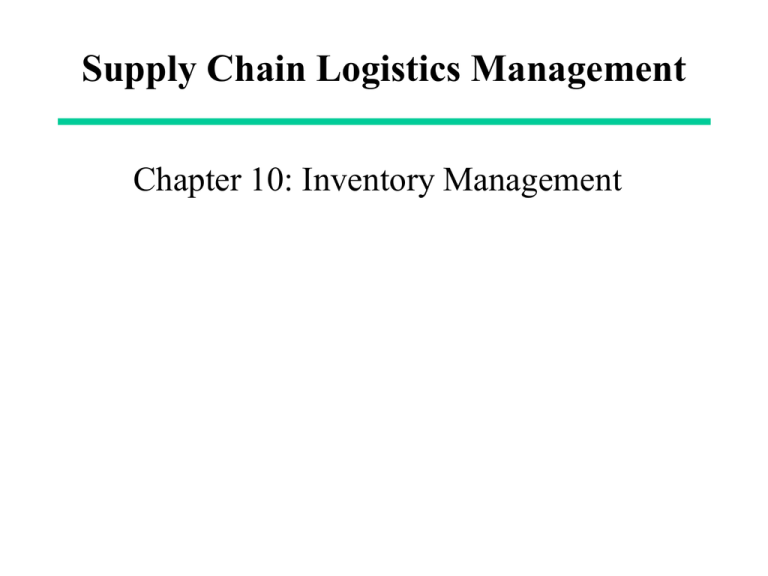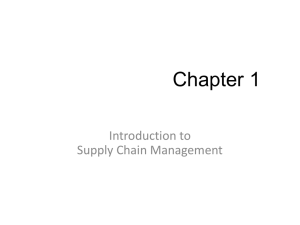
Supply Chain Logistics Management
Chapter 10: Inventory Management
Focusing on Inventory
•
•
•
•
•
Sales = $100,000
Average inventory = $50,000
Range of inventory ($30,000 - 70,000)
Annual turns = 2.00
Days of supply = 180
Supply Chain Logistics Management, First Edition , Bowersox, Closs, and Cooper
Copyright© 2002 by The McGraw-Hill Companies, Inc. All rights reserved.
“Peeling the Inventory Onion”
Inv. Comp.
Cycle
In Transit
Inventory
20,000
5,000
Obsolescence/
Damage
Speculative
10,000
Safety stock
10,000
5,000
Days Rationale
72 Cycle time range of
$40,000
18 Transit delay
36 Obsolete and
damaged goods
18 Forward buy for
discount
36 To meet service
rqmnts.
Supply Chain Logistics Management, First Edition , Bowersox, Closs, and Cooper
Copyright© 2002 by The McGraw-Hill Companies, Inc. All rights reserved.
Product Positioning Decision Factors
• Accurate assessment of inventory value
• Assignment of responsibility for inventory
carrying costs
–
–
–
–
Opportunity cost (15%)
Taxes and insurance(1%)
Pilferage and obsolescence (1%)
Storage (2%)
Supply Chain Logistics Management, First Edition , Bowersox, Closs, and Cooper
Copyright© 2002 by The McGraw-Hill Companies, Inc. All rights reserved.
Perspectives on Product Positioning
• Provide for uncertainty - Inventory
management
• Reduce demand uncertainty
• Reduce cycle uncertainty
Supply Chain Logistics Management, First Edition , Bowersox, Closs, and Cooper
Copyright© 2002 by The McGraw-Hill Companies, Inc. All rights reserved.
Provide for Uncertainty
Inventory Management
• Manage
– Where to stock?
– When to order?
– How much to order?
• Control
– Accountability
– Accuracy
Supply Chain Logistics Management, First Edition , Bowersox, Closs, and Cooper
Copyright© 2002 by The McGraw-Hill Companies, Inc. All rights reserved.
Inventory Cycle for Typical Product
2
months
Average Inventory
1.5 months
1.5
months
1.0
Safety Stock
months
1
2
Supply Chain Logistics Management, First Edition , Bowersox, Closs, and Cooper
Copyright© 2002 by The McGraw-Hill Companies, Inc. All rights reserved.
Elements Influencing Average Inventory
• Average = OQ/2 + SS + IT
• Where:
–
–
–
–
Average = average inventory level
OQ = average replenishment order quantity
SS = average safety stock level
IT = average in-transit inventory
Supply Chain Logistics Management, First Edition , Bowersox, Closs, and Cooper
Copyright© 2002 by The McGraw-Hill Companies, Inc. All rights reserved.
Reorder Point and Safety Stock
When to order
• ROP = LT * DD + SS
• Where:
–
–
–
–
ROP = reorder point
LT = replenishment lead time
DD = average daily demand
SS = safety stock
Supply Chain Logistics Management, First Edition , Bowersox, Closs, and Cooper
Copyright© 2002 by The McGraw-Hill Companies, Inc. All rights reserved.
Inventory Cycle for Typical Product
2
months
Average Inventory
1.5 months
1.5
months
1.0
Safety Stock
months
1
2
Supply Chain Logistics Management, First Edition , Bowersox, Closs, and Cooper
Copyright© 2002 by The McGraw-Hill Companies, Inc. All rights reserved.
Factors Influencing Safety Stock
Requirements
Demand
Lead time
Service
Level
(SL)
f(k) * C
Forecast
OQ
Replenishment
cycle
Transport mode
Supply Chain Logistics Management, First Edition , Bowersox, Closs, and Cooper
Copyright© 2002 by The McGraw-Hill Companies, Inc. All rights reserved.
Determining Safety Stock
• f(k) = (1 - SL) * (OQ/C)
• Where:
– f(k) = Normal loss integral for safety factor k
– SL = desired service level in percent unit fill
rate
– OQ = order quantity
– C = standard deviation of lead time demand
Supply Chain Logistics Management, First Edition , Bowersox, Closs, and Cooper
Copyright© 2002 by The McGraw-Hill Companies, Inc. All rights reserved.
Example Safety Stock Calculation
• Key parameters
–
–
–
–
SL = 99 percent availability
DD = 5 units/day, DD = 2.54
LT = 10 days, LT = 2
OQ = 300 units
Supply Chain Logistics Management, First Edition , Bowersox, Closs, and Cooper
Copyright© 2002 by The McGraw-Hill Companies, Inc. All rights reserved.
Combining Demand and Lead
Time Uncertainty
+
Lead Time
LT = 10
LT = 2.00
=
Demand
DD = 5
DD = 2.54
Average LTD (Lead time demand) = LT * DD = 50
Supply Chain Logistics Management, First Edition , Bowersox, Closs, and Cooper
Copyright© 2002 by The McGraw-Hill Companies, Inc. All rights reserved.
Combined Uncertainty
C = LT * DD2 + DD2 * LT2
=
C
10 * 2.542 + 52 * 2.002
C = 12.83 (rounded to 13)
Supply Chain Logistics Management, First Edition , Bowersox, Closs, and Cooper
Copyright© 2002 by The McGraw-Hill Companies, Inc. All rights reserved.
Table of Normal Loss Integral
k
f(k)
k
f(k)
k
f(k)
0.0
0.3989
0.7
0.1428
1.4
0.0366
0.1
0.3509
0.8
0.1202
1.5
0.0293
0.2
0.3068
0.9
0.1004
1.6
0.0232
0.3
0.2667
1.0
0.0833
1.7
0.0142
0.4
0.2304
1.1
0.0686
1.8
0.0110
0.5
0.1977
1.2
0.0561
1.9
0.0084
0.6
0.1686
1.3
0.0455
2.0
0.0074
Supply Chain Logistics Management, First Edition , Bowersox, Closs, and Cooper
Copyright© 2002 by The McGraw-Hill Companies, Inc. All rights reserved.
Calculating Safety Stock k factor
f(k) = (1 - SL) * (OQ/C)
f(k) = (1.0 - .99) * (300/13)
= 0.2308
f(k) = 0.2308 ==> k =0.4
SS = k * C
= 0.4 * 13
= 5.2 units (Round to 6)
ROP = DD * LT + SS = 50 + 6 = 56
Supply Chain Logistics Management, First Edition , Bowersox, Closs, and Cooper
Copyright© 2002 by The McGraw-Hill Companies, Inc. All rights reserved.
Inventory Management Policy
Allowing for Uncertainty
• When inventory-on-hand plus on-order is
less than or equal to 56, order 300
Supply Chain Logistics Management, First Edition , Bowersox, Closs, and Cooper
Copyright© 2002 by The McGraw-Hill Companies, Inc. All rights reserved.
Impact of Changes in Uncertainty Level
Demand Leadtime
12.83
12.83
1.5
15.66
17.01
2
18.92
21.55
30
2.5
22.43
26.26
3
26.09
31.06
Combined Standard Deviation
35
1
25
Demand
Leadtime
20
15
10
5
0
1
1.5
2
2.5
3
Multiples of Standard Deviation
Supply Chain Logistics Management, First Edition , Bowersox, Closs, and Cooper
Copyright© 2002 by The McGraw-Hill Companies, Inc. All rights reserved.
Impact of Order Quantity on Safety
Stock
Order
Quantity
300
k
Safety Average
Stock Inventory
5.2
155
0.40
200
0.65
8.4
108
100
1.05
13.6
64
Supply Chain Logistics Management, First Edition , Bowersox, Closs, and Cooper
Copyright© 2002 by The McGraw-Hill Companies, Inc. All rights reserved.
Graphical Illustration of Locational Impact of
Inventory
Total Inventory
Average
Inventory
Safety Stock
Cycle Stock
Stocking Locations
Supply Chain Logistics Management, First Edition , Bowersox, Closs, and Cooper
Copyright© 2002 by The McGraw-Hill Companies, Inc. All rights reserved.
Distribution Resource Planning
• Example
• Benefits and risks
Supply Chain Logistics Management, First Edition , Bowersox, Closs, and Cooper
Copyright© 2002 by The McGraw-Hill Companies, Inc. All rights reserved.
Distribution Resource Planning
Benefits and Risks
• Benefits
– Reduced freight and
inventory
– Improved coordination
with marketing
– Decreased space
requirements
– Enhanced budgeting
capability
• Risks
– Requires good
forecasting accuracy
– Requires change to
planning mentality
– Subject to system
“nervousness” with
changing forecasts
Supply Chain Logistics Management, First Edition , Bowersox, Closs, and Cooper
Copyright© 2002 by The McGraw-Hill Companies, Inc. All rights reserved.
Stratified Product Positioning
• Fine-line (ABC) analysis
• Stratified management guidelines
Supply Chain Logistics Management, First Edition , Bowersox, Closs, and Cooper
Copyright© 2002 by The McGraw-Hill Companies, Inc. All rights reserved.
Product Classification Analysis (ABC)
Product
Number
Sales (000)
1
2
3
4
5
6
7
8
9
10
11
12
45,000
35,000
25,000
15,000
8,000
5,000
4,000
3,000
2,000
1,000
1,000
1,000
20
250
Percent of Cumulatove Cumulatirve
Sales Sales Percent
Products
Percent
30.0
30.0
5
23.3
53.3
10
16.7
70.0
15
10.0
80.0
20
5.3
85.3
25
3.3
88.7
30
2.7
91.3
35
2.0
93.3
40
1.3
94.7
45
0.7
95.3
50
0.7
96.0
55
0.7
96.7
60
0.2
100.00
100
Category
A
A
A
A
B
B
B
B
B
B
C
C
C
Supply Chain Logistics Management, First Edition , Bowersox, Closs, and Cooper
Copyright© 2002 by The McGraw-Hill Companies, Inc. All rights reserved.
Sample Integrated Strategy
SKU Service
Forecast Review
Category Objective
Period
Inventory Stocking
Mgt
Policy
Promotional 100%
A
CFAR
Daily
DRP
Scheduled
A
99%
Top down
Daily
DRP
Full line
B
98%
Bottom up
Time series
Weekly
DRP
Select
locations
C
90%
Bottom up Weekly
Time Series
ROP
Centralized
Supply Chain Logistics Management, First Edition , Bowersox, Closs, and Cooper
Copyright© 2002 by The McGraw-Hill Companies, Inc. All rights reserved.
Conclusions
• Allow for uncertainty
– Inventory management and control
• Reduce demand uncertainty
–
–
–
–
–
Forecasting
DRP
Simplification
Demand management
Postponement
• Reduce cycle uncertainty
– Exert more control over cycle times
– Supply chain management
– Variable assignment
Supply Chain Logistics Management, First Edition , Bowersox, Closs, and Cooper
Copyright© 2002 by The McGraw-Hill Companies, Inc. All rights reserved.










